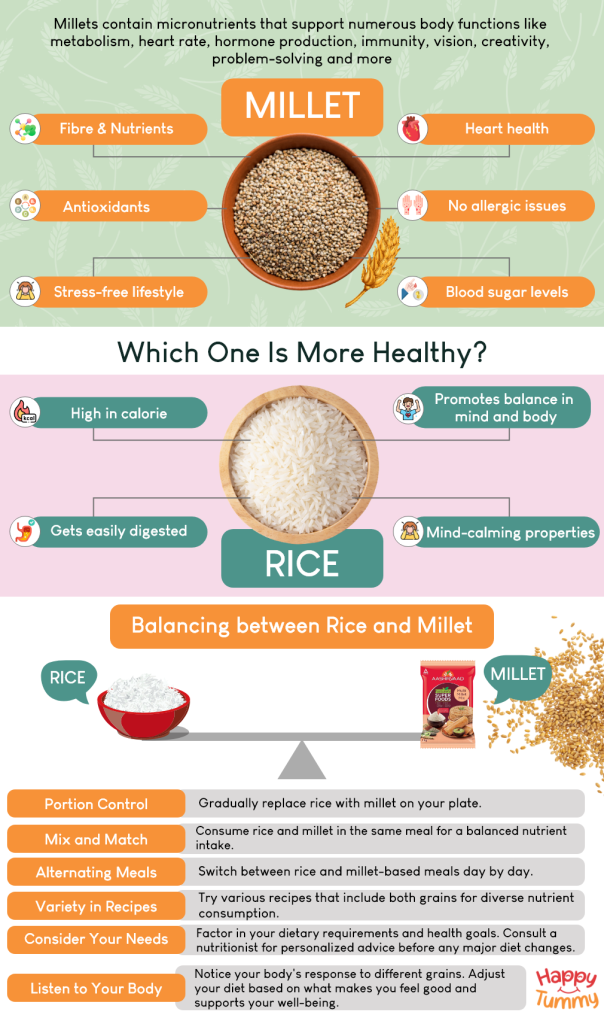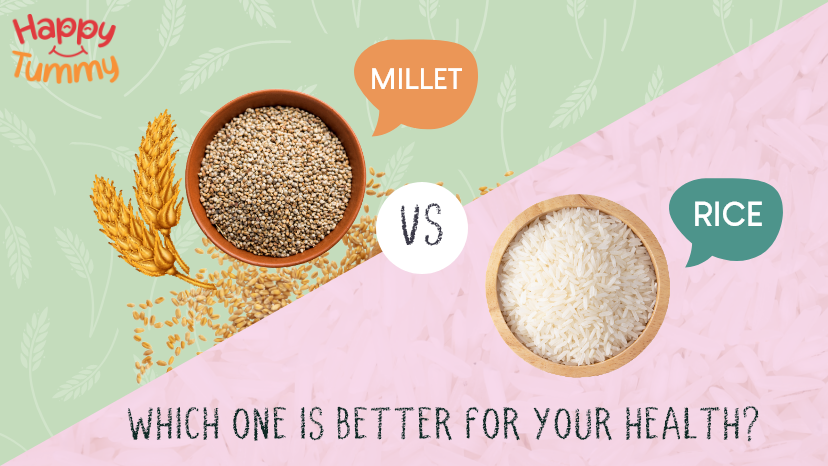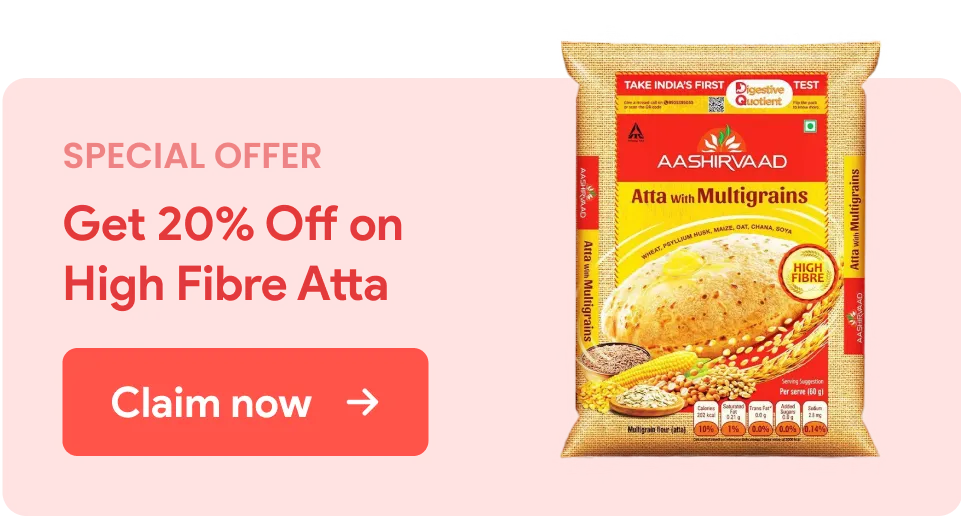Table of Contents
The veins of India run on rice. This needs no head-scratching. It is easy to cook, is affordable, and goes well with almost anything. The only grain that gives it a good whacking contest is wheat. And then the number plummets.
The reason being our peerless eye-sparkling love for rice. But do we have other options? Yes, we do. In the age of light-speed internet, many other grains have got a new breath of life.
Millet is one of those. And it is making everyone rethink their food choices.
But, should you replace your rice with Millet? Let’s dive into the bowl and stir this rice v/s millet debate.
Millet vs Rice – the nutritional debate
| Nutritional Factors | Cooked white rice – 100 grams [1] | Cooked Millet – 100 grams [2] |
| Energy | 130 kcal | 119 kcal |
| Water content | 68.4 grams | 71.4 grams |
| Protein | 2.69 grams | 3.51 grams |
| Fat | 0.28 grams | 1 gram |
| Carbs | 28.2 grams | 23.7 grams |
| Dietary Fibre | 0.4 grams | 1.3 grams |
| Minerals | Calcium, Magnesium, Phosphorous, Potassium, Zinc, Copper, Manganese, Selenium, etc. | Calcium, Iron, Magnesium, Phosphorous, Potassium, Sodium, Zinc, Copper, Manganese, Selenium |
| Vitamins | Choline, Vitamin B, Vitamin E | Vitamin B, Folate, Choline, Carotene, Vitamin A, Vitamin K, Lutein, Zeaxanthin, Thiamine, Riboflavin, Niacin, etc. |
Calorie wise they seem no less than some siblings. In fact, rice takes a bit of an upper hand. This is the reason farmers eat lots of rice while working in the field. It is quick energy. But you don’t depend on energy alone. Do you?
Energy can be good and can be bad as well. So, we look over the calories toward things that really matter.
To keep going on fluidly through our daily lives, we need to have adequate vitamins and minerals as well. These micronutrients support numerous body functions like metabolism, heart rate, hormone production, immunity, vision, creativity, and problem-solving, and the list is ceaseless.
And Millets excels at almost all these.
Rice has three minerals in amounts higher than millet: calcium, manganese, and selenium. And when it comes to vitamins, rice stands a little behind.
So, even though rice provides a bit more calories than millet, it has lower amounts of vitamins and minerals.

Millet is a gem, but!
When you own a vehicle, you do not depend on fuel alone. You need to have your ride have regular services, engine oil changed, cleaning, brushing, tire maintenance, and all that troublesome but necessary. And so is with our bodies. There are a few things that ensure we smile while living:
- Fibre
- Antioxidants
- No allergic issues
- Nutrients
- Heart health
- Blood sugar levels
- And stress-free lifestyle
First of all, fibre: Fibre is the cleaner, feeds your good gut bacteria, and helps you have food motions. If you don’t have enough, you suffer from digestive issues. And millet has it more than rice. The amount is over 3 times.
Antioxidants: Now, again, rice indeed contains antioxidants, but in amounts much lower than millet. These antioxidants protect our cells from damage, prevent quick ageing, strengthen immunity, etc.
Heart Health and Blood Sugar: Then it comes down to heart health and beloved blood sugar levels. Indeed, antioxidants are a boon for the heart. They let our hearts rock and roll on merry beats. But antioxidants are not the only molecules that help the heart. Apart from it, these grains have a low glycaemic index. It simply means your blood sugar doesn’t rise immediately after cherishing dishes made using it.
Nutrients: Magnesium is a mineral that is melodious to our mellow hearts. This mineral sets the human heart in the right rhythm. It ensures that we do not get abnormal heartbeats (except when a blissful beauty passes by while smiling at us). And millet is rich in magnesium. A mere 100 grams of cooked millet infuses in us 44 mg of magnesium — 4 times higher than rice.
But this does not make Rice a villain.
Rice- Millet’s favourite counterpart
Undoubtedly, millet is a gem of a grain. But this does not vilify it in our millet v/s rice story. Rice has been a staple of cultures throughout the Indian gastronomical spans. But because the culture is taking a shift toward better nutrition, rice is being downplayed by other healthy players like millet. But this is not the absolute message here and we highly recommend finding the balance between these two amazing grains.
Ayurveda speaks of rice as sattvic. It means that rice is potent of these things:
- mind-calming properties
- provides clarity
- promotes balance in mind and body
- Gut friendly
It is often seen as coolant food. This is truer for white rice than brown rice. It has a sweet taste and cooling energies. As a result, your pitta dosh is neutralized. This is why when you have an upset stomach, kichdi or plain dal-rice is suggested.
But there is one issue with rice. Because rice has a higher GI index, it should be consumed in moderation, especially by diabetic people. But what should you choose?
How to balance Rice and Millet?
Balancing between rice and millet in your diet can be achieved by following these tips:
Portion Control: Consider the proportion of rice and millet on your plate. Start by replacing a portion of rice with an equal amount of millet. Gradually increase the millet portion and reduce the rice portion over time. You can also add millet to your rotis to balance this. It’s easy. Just add the Aashirvaad Multi-millet mix to your regular atta and balance the portion of rice and roti on your plate. Simple!
Mix and Match: Instead of consuming only rice or millet in a single meal, mix them together. Cook a combination of rice and millet to create a balanced grain blend. This way, you can enjoy the benefits of both grains.
Alternating Meals: Plan your meals in such a way that you alternate between rice and millet. For example, have rice-based meals one day and millet-based meals the next day. This helps in diversifying your grain intake and ensures a balanced approach. You can use a meal planner to ace this step.
Variety in Recipes: Explore different recipes that incorporate both rice and millet. This will not only add variety to your meals but also ensure a balanced intake of nutrients from both grains. For example, you can make millet dosa by adding the Millet mix to your dosa batter. For more recipes check this!
Top 10 Millet Food Recipes You Can Make at Home
Consider Your Needs: Take into account your specific dietary needs and health goals. If you are trying to reduce your carbohydrate intake or manage blood sugar levels, you may opt for more millet and less rice. Consult with a nutritionist or your physician for personalized guidance before making any sudden shift in your diet. This is crucial if you have any health concerns.
Listen to Your Body: A lot of time, we avoid what our bodies are telling us and succumb to the temptation. Firstly, pay attention when your body tells you to stop stuffing it with junk food. Then, pay attention to how your body responds to different grain combinations. Notice how you feel after consuming rice or millet-based meals. Adjust the balance according to what makes you feel energized, and satisfied, and maintains your overall well-being.
Remember, the key is to find a balance that works for you and supports your individual health goals. It’s always a good idea to consult with a professional or a dietitian for personalized advice based on your specific needs.
Conclusion
When it comes down to diet and digestion, diversity is the key. Indeed, millet is higher in terms of nutrition and health benefits, but this doesn’t devour the benefits of rice. After all, skipping on the delicious biryanis is a sin indeed. So, where lies the line? The answer is – nowhere,
The choice between millet and rice ultimately depends on individual preferences. Also, dietary needs and cultural choices make their play. Where rice is quick and cool energy, millet is nutrition dense.
And if the rice has a few issues, choosing brown rice does work to cover up its drawbacks. But then, the taste is the issue.
The key takeaway is to have a diet that includes both. You should neither depend on rice nor on millet. Also, try having lots of fruits and vegetables each day. Eat dry fruits, seafood, laugh, play, and cherish life. Don’t skip on that luscious biryani or kheer. But alongside, enjoy those spicy millet pops, millet pulao, ragi laddu, and everything pretty millety.
FAQs
Millet and rice are both grains, but they have distinct differences. Millet is a group of small-seeded grains, while rice is a single grain. Millet is gluten-free and has a nuttier flavour, while rice contains gluten and has a milder taste.
Millet and rice have different nutritional profiles. Millet is generally higher in fibre, protein, and micronutrients like iron and magnesium. However, rice is often fortified with nutrients like folic acid.
Both millet and rice can be part of a weight-loss diet when consumed in moderation. Millets are higher in fibre and protein, which can help you feel fuller for longer and control your appetite. However, portion control and overall calorie intake are crucial for weight loss regardless of the grain choice.
Millet is a gluten-free grain, making it an excellent choice for individuals with gluten intolerance or celiac disease. Rice, on the other hand, contains gluten.
Millets and rice can be used interchangeably in some recipes, depending on the desired texture and flavour. However, it is important to note that millets have a different cooking time and water ratio compared to rice. It may require some adjustments when substituting one for the other.
Rice is traditionally more widely used in various cuisines and can be prepared in different ways like steamed, boiled, or fried. However, millets have gained popularity for their versatility and can be used in a wide range of recipes, including pilafs, porridges, salads, and baked goods.
Can millet and rice be part of a balanced diet?
Both millet and rice can be part of a balanced diet. They provide carbohydrates, fibre, and essential nutrients. It is important to incorporate a variety of grains, including millet and rice, along with other food groups to ensure a well-rounded and nutritious die.















